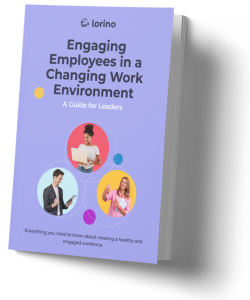When it comes to feedback, it’s usually seen as a mandatory manager duty—something to be doled out during annual reviews or in response to a job completed. But feedback isn’t a one-time deal. Or at least it shouldn't be.

If you’re only offering feedback when requested or after the performance is done, you’re missing out on the big picture of what it can do for your team, because regular (and unasked-for) positive reinforcement can be a game-changer in employee empowerment and therefore engagement, motivation, and productivity.
As a manager, it’s time to take a more proactive approach and start using positive reinforcement to keep employees at the top of their game.
Let’s dive into how it can be done!
What is Positive Reinforcement and How Does it Affect Productivity?
So let's start with the basics. Positive reinforcement is a type of behavior modification technique used to encourage and reward desired behaviors in order to increase their frequency or intensity.
It can be done by providing verbal praise, rewards, acknowledgment of accomplishments, or other forms of recognition.
Simply put: positive reinforcement works because it creates an environment where employees are motivated to engage in the same behavior that received a reward in the past.
This means that employees are more likely to repeat certain behaviors when they know they will be acknowledged and rewarded.
The Benefits of Positive Reinforcement
And while that is all true and proven to work, another aspect that should not be overlooked is how regular positive feedback impacts employee empowerment and motivation.
When an employee consistently receives acknowledgments for their efforts, it creates a feeling of being seen, heard, and appreciated—all of which are crucial when it comes to engagement with the job itself.
As a result, productivity increases as employees are more motivated to work hard and tackle tasks. Not to mention that it also boosts their morale which in turn leads to better team cohesion and communication.
Also, workplace stress isn't always about the workload. Often, it's about the lack of recognition. Positive reinforcement is a great way to provide that feeling of recognition and appreciation, leading to fewer burnouts and improved well-being.
It encourages employees to strive for better results and do their best work, giving them the motivation they need to keep going.
The Drawbacks of Positive Reinforcement
There are none. Well, not entirely true.
When used incorrectly or without caution, positive reinforcement can backfire and lead to decreased motivation.
This happens when the rewards given are too frequent or unrelated to performance – in other words, empty rewards just for doing what’s expected.
But other than that it's a cheap, easy, and effective way to reward employees and foster a positive working environment.
How to Use Positive Reinforcement Effectively
So there's more than one benefit to using positive reinforcement in the workplace, and more importantly - there are basically no drawbacks if used correctly.
The key to success with positive reinforcement is making sure the rewards are meaningful and tied directly to performance, and that they’re not given too frequently or for basic tasks.
But, how do you do that without falling back into the habit of providing feedback only once or twice a year, or when an employee fails to meet expectations?
Simple - by focusing on the positive and rewarding employees for their successes no matter how small.
The goal is to see and reward successes, not tasks. This keeps employees motivated and allows for continuous growth, both professionally and emotionally.
Here are some tips on how to use positive reinforcement effectively:
1. Be specific and timely.
In order for positive reinforcement to be effective, employees must understand why they’re being rewarded. Instead of simply saying “good job” or “well done”, make sure to include specifics such as what was done well and why it merits a reward.
It's also important to reward employees in a timely fashion - don't wait until the end of the year to give praise.
2. Focus on efforts and outcomes, not the tasks.
Focus on praising employees for their efforts and achievements, instead of simply rewarding them for completing tasks.
For example, if an employee goes above and beyond to create a new process to make the team more efficient, they should be rewarded for not only creating the process but also coming up with the idea and taking the initiative to implement it.
3. Make sure the rewards are meaningful.
Make sure that any rewards you give are meaningful and tailored to individual employees’ interests and preferences.
Don’t just buy a bunch of gift cards and hand them out without any thought - make sure the reward is something that will be appreciated. So if the employee in question is into sports, then tickets to a local game would be an appropriate reward.
But if they are more into music, then concert tickets may be a better option.
4. Be consistent and fair.
Everyone should have the same chance at rewards, regardless of their roles or rank in the company.
Remember, the goal here is not to create a competitive cut-throat culture, so be sure to give everyone the same opportunities. And tied to the last point: the rewards need to be consistent as well.
The value of the rewards should be at the same level, no matter who receives them. This will ensure everyone is treated fairly and that the reward system remains equitable.
5. Be sincere and authentic.
Don’t give positive reinforcement just for the sake of it or because you feel obligated to do so. Make sure you are genuine and sincere in your praise, and avoid exaggerating or overdoing it.
Employees can tell when you are being insincere or dishonest, and that can undermine your credibility and trust. For example, don’t say “You are the best employee ever” if you don’t really mean it or if you say it to everyone.
6. Celebrate successes publicly.
When an employee has achieved something noteworthy, celebrate their success with the rest of the team - give them a shoutout in a meeting or on your social intranet, and recognize their accomplishments to everyone in the organization.
Celebrating achievements and successes like this can be a great way to create an atmosphere of motivation and collaboration in the workplace.
Examples of Positive Reinforcement in Action
This all might now seem a lot more complicated than it needs to be. So, let’s look at a few examples of how to deliver positive reinforcement in action:
-
A manager sends a thank-you card to an employee who stayed late to finish a report, along with a gift card to their favorite coffee shop.
-
A team leader gives a shout-out to a team member who helped a colleague with a difficult task, during a team meeting.
